Documents
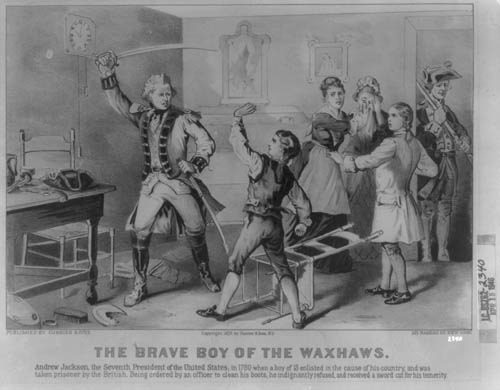
1. Figure 2.1
“The Brave Boy of the Waxhaws”
1780
Engraving depicting the young Jackson during the American Revolution refusing to shine the boots of a British officer.
Source: Currier and Ives, 1876
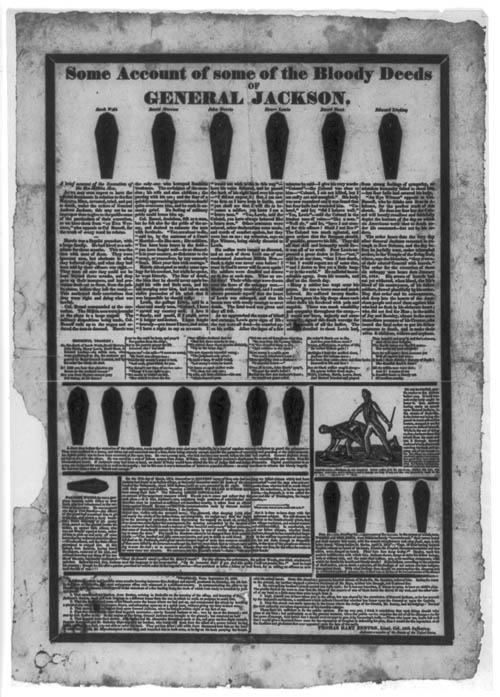
2. Figure 2.2
Jackson brawl with Samuel Jackson - 1807
The cartoon and text recounts Jackson’s encounter with Samuel Jackson on the streets of Nashville in 1807. The anti-Jackson message attacks the general as behaving in a less than honorable manner.
Source: John Binns, “Coffin Bills”—1828, Library of Congress
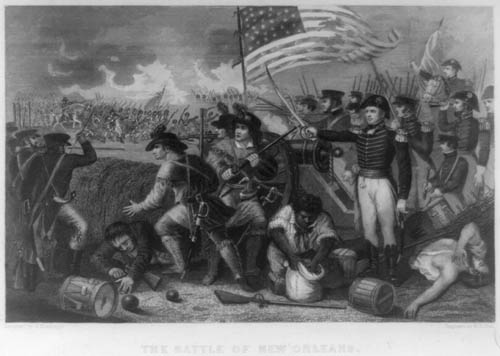
3. Figure 2.3
Jackson at the Battle of New Orleans—1815
An engraving of Jackson inspiring his men in their legendary victory against the British in the war of 1812. The artist offers a romanticized view of the battle, but does include the complexity of the American forces (regulars, frontiersmen, African Americans), the role of artillery, and the cotton bale defense.
Source: H. B. Ball engraving, national archives

4. Figure 2.4
“The Caucus Curs”—Election of 1824
A cartoon in the election of 1824 that shows the noble Jackson in uniform staring down the “Caucus Curs” (representatives of the democratic republican party) and the critical press who would take the nomination and the presidency away from him.
Source: James Akin, Library of Congress
5. Andrew Jackson evaluates John Quincy Adams and Henry Clay (1825)
“You have seen from the public journals that the rumors of union, & barter for office, between Mr. Clay’s friends and Mr. Adams, have been verified by the result of the presidential election. The information now is, that the contract, so far as Mr. Clay is concerned, is fulfilled, by the offer of Mr. Adams to Mr. Clay of the appointment of Secretary of State, which it is said Mr. Clay has agreed to accept. I have, as you know, always though Mr. Adams to be an honest, virtuous man, and had he spurned from him those men who have abandoned those principles they have always advocated (that the people have a right to govern) and that their will should be always obeyed by their constituents; I should still have viewed him an honest man; and that the rumors of bargain and sale was unknown to him. . . .
From Mr. Clay’s late conduct, my opinion of him, long ago expressed, is but realized—from his conduct on the Seminole question, I then pronounced him a political gambler—and from his late conduct in the abandonment of all those republican principles which he always professed and by which he obtained the support of the people, and forming such an alliance so unexpectedly, with a man he denounced before the nation, and all this for the office of Secretary of State realizes the fact of his gambling. Would it be too much to infer that his ambition might induce him to reach the executive chair by open and direct bribery, as well as the barter of office—these are my reflections, and I cannot from the scenes lately, and now acting here, refrain from shuddering for the liberty of my country.”
Source: Andrew Jackson, February 20, 1825, to William B. Lewis, Harold D. Moser, ed., The Papers of Andrew Jackson, vi (Knoxville: University of Tennessee Press, 2002), 36-37.

6. Figure 2.5
Portrait of Rachel Donelson Jackson
Ca. 1823
Source: Ralph E.W. Earl, artist

7. Table 2.1
State by state white male voting patterns and turnout in the elections of 1824-1844.
Source: Historical Statistics of the United States, 1789-1945. Washington, D.C.: U.S. Bureau of the Census, 1949, 293
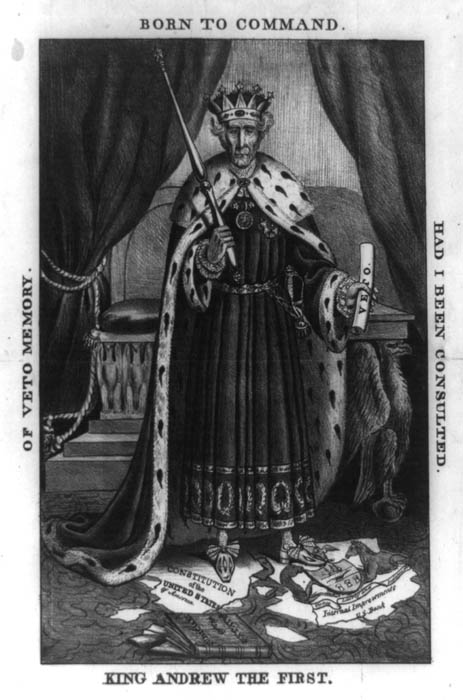
8. Figure 2.6
“King Andrew the First”
1833
Anti-Jackson cartoon outlining the issues of abuse of executive power and in violation of the Constitution committed by “King Andrew I” against the American people.
Source: Library of Congress

9. Figure 2.7
Office Hunters
1834
Jackson as a winged demon holds the strings to political office. The eager people below reach out for reward under the controversial “spoils system.”
Source: Anthony Imbert, Smithsonian Museum of American History.
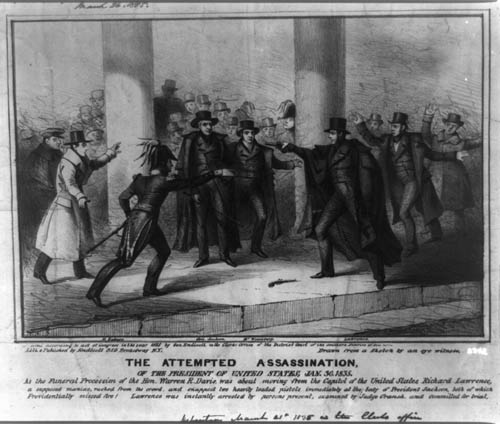
10. Figure 2.8
Attempted Assassination of Andrew Jackson
1835
Source: Endicott, New York, Library of Congress
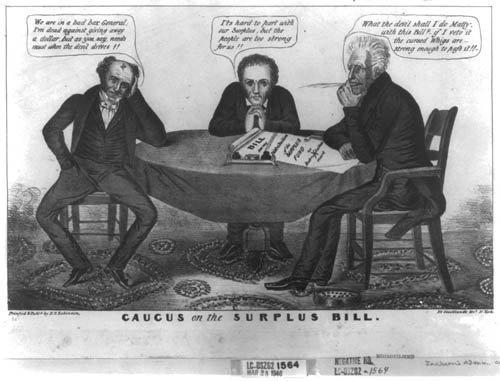
11. Figure 2.9
Caucus on the surplus (distribution) bill
1836
A critical cartoon portraying the debate among Jackson, Vice President Martin van Buren (aspiring to the presidency) and his running mate Richard M. Johnson on the popularity of the surplus (distribution) bill among the people.
Source: H. H. Robinson, Library of Congress

12. Figure 2.10
Andrew Jackson a few months before his death
1845
Source: Thomas Doney, Library of Congress
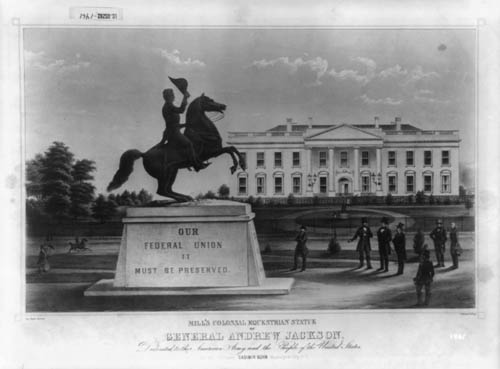
13. Figure 2.11
Jackson remembered:
Clark Mills’s statue of Jackson in Lafayette Square, Washington, D.C.
1868
Source: Library of Congress
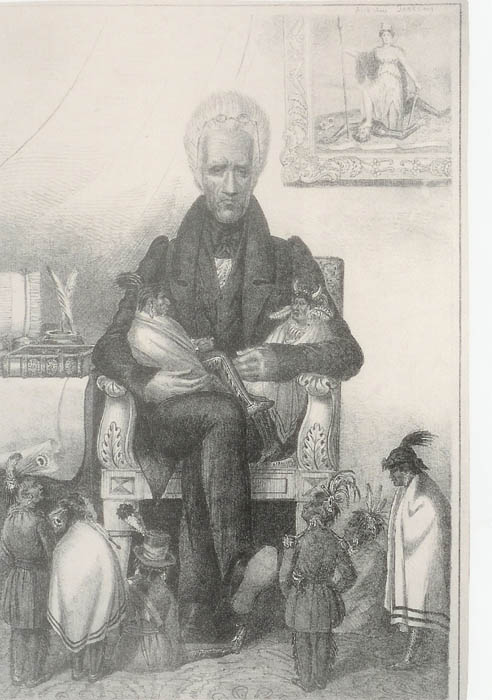
14. Figure 2.12
The Great Father
1835
The cartoon of Jackson as “the Great Father” to the Indians depicts a protective President, nurturing and looking after the various nations. Many had recently been removed beyond the Mississippi River.
Source: University of Michigan, Clements Library